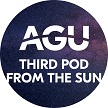Policy
Fieldwork rocks: Can it be accessible for all?
When we imagine a geologist striding through the mountains, carrying heavy samples and equipment, the picture omits a lot of people. Scientists with mobility, vision and hearing impairments or other disabilities have a much longer road to walk to get to the field sites geologists often seek.
Read MoreYour favorites: A Martian on Earth
Tanya Harrison never thought she was going to be an astronaut. But she was determined to go to space. And she did just that – through satellites, first to Mars, and now looking back at our own third rock from the Sun as she uses satellites to map places near and far.
Read MoreDistillations: Mapping the seafloor with computer games
Many might think that we know most or all there is to know about our world. On the surface, that might be somewhat true. But below the surfaced, we’ve mapped less of the oceans than of places outside our world like Mars and our moon.
Read MoreDistillations: Quilting science & changing climates
When you think of a combo of science & art, what comes to mind? Drawings? Dance? Music? How about quilting? Laura Guertin, Professor of Earth Science at Penn State Brandywine, was looking for creative and innovative to do just that when she came across the idea of showing the effects of climate change (among other things) via quilts!
Read More30-Fire: Bringing fire back to the land
Fire is a part of life for many indigenous groups, but for decades cultural burning was restricted and even criminalized. Now, fire is being brought back to the land by indigenous groups to help prevent big blazes, create resilient ecosystems, and provide resources for indigenous communities.
Read More25-Fire: Forests under (mega)fire in the Pacific Northwest
Climate change is accelerating as human-made greenhouse gasses continue to warm our atmosphere. Megafires certainly evoke climate change doomsday feelings, but are these types of fires new to the PNW or were similar instances occurring prior to 2020?
Read More18.5-The (not so) secret histories of scientists
Science is all about experimentation, discover, and sharing those results. But what happens behind the scenes? What stories do scientists have to tell that don’t make it in the manuscript or the classroom lecture?
Read More18-Ice: Ancient knowledge for modern tech
To the untrained eye, Arctic ice appears unchanging, but conditions can shift quickly, and often reveal life-threatening hazards when they do. It is an unforgiving environment, but the Inuit know how to navigate it. That knowledge has been passed down through generations, and a new app is giving centuries-old Inuit knowledge a very modern form.
Read More12.5-A podcast of ice and fire
Cool off from the summer heat with our next six-part miniseries all about ice – from those who call it home to its use as a tool in science.
Read More12-Extinctions: Space station splashdown
The International Space Station feels like a permanent fixture. It’s been up there since 2000! But earlier this year, NASA announced it is bringing the ISS back to earth in the 2030s as it plans for new space stations.
Read More









